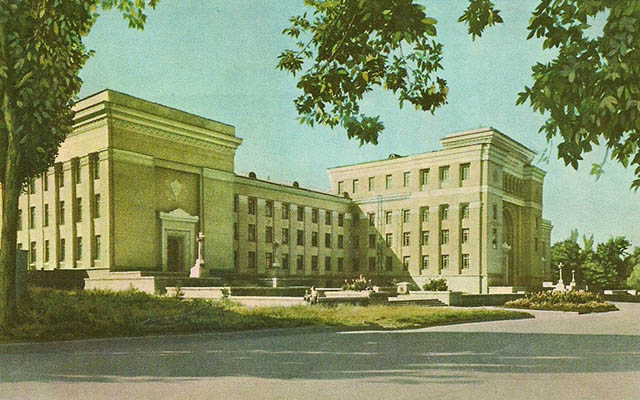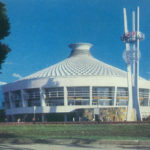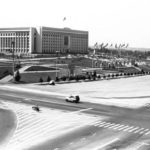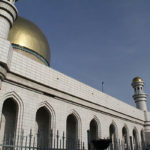The city grew before our eyes, new buildings appeared, grew the church, decorating the cityscapes. Above from designing new structures have been working proactive self-taught, but also graduates, architects and engineers who took training courses in the best-known institutions of higher learning, such as for example the St. Petersburg Academy of Engineering, Institute of Communications and Civil Engineering. Among the first masters, giving the first appearance of the newly born city were Aleksandrovsiky L. Gumnitsky Ts, Kamenogradsky A. Kryshtanovskaya N. Serebrennikov Renowned architect erected the first cathedral in the city. Alas, now see it is not possible, it was razed to the ground in the middle of the 30s of the twentieth century. Now this place is a park Amangeldy Imanov.
The second most important architect of the city, which gave return it to the pre-revolutionary image became famous Frenchman Paul Gorda. He not only put on the physical form of the image of the first emblem of the city, but also created the first detailed map of the area of Jeti-Su, which was subsequently shown at the Paris International Exhibition. Gorda Architect not only created the look of the future capital of the Kazakh Soviet Republic, but also trying to figure out how to look past the settlement. During the construction of new buildings he excavated and studied the relics that have survived from the past, thus immeasurably enriched the collection of the city, as well as its historical baggage. For his numerous achievements he was even given the title of honorary citizen of the Faithful.
The rich look and a nice reputation for comfort settlement largely created by local merchants who generously donated funds for the construction of public buildings. Thanks to their rich donations, in the space of the Faithful were churches and schools, equipped with every comfort. Their money has been rebuilt and military institutions. True was the city, welcome relating to a variety of denominations. Two synagogues, mosques, and as many as eleven of the Roman Catholic Church and other churches, appeared in the city thanks to the generosity of patrons. We have survived Turkestan Cathedral and Church, named in honor of Our Lady of Kazan.
In the face of the city is largely influenced by the local seismological features and construction of tall stone buildings in the city were not reasonable, not only because of the frequent earthquakes, but also because of the climate characteristics. Streets decorated one-story, pretending to the structure of the Earth. To give the appearance of the city originality and give the image of the city of some traditional, elegant appearance with a paraphrase of the old Russia, all the houses here were richly decorated with carvings and log-crowned gabled roof, and with beams looking at passers thoughtful wooden muzzles of animals. Streets, to which have not yet reached, powdered dust of the desert, would have looked so sad without beautiful and neat wooden houses. To add more charm is not particularly well-kept boulevards and promenades gave bright and large signs, belonging to different companies. Here you can see and places such as the fashion houses, trading houses, many hotels and restaurants. Soon appeared in the city are essential elements of modern civilization as telephone, piping and electricity. In the streets, except rollicking cabs, and proudly wandering camels, fun and provocatively first cars rattled.
From the first of mortgaged stone city has been steadily growing, expanding mainly in the south-west side. There are the first streets and squares, built temples. But despite all the efforts of diligent builders, the first experience was not as successful as hoped for architects. In 1887, after the first strong earthquake, the city fell in ruins. Especially dramatic was the fact that she found the element of townspeople sound asleep, the first tremors began to shake the ground floor four in the morning. In just 5 minutes a miserable useless dust and debris has become a sad fact that was erected for two decades. On the face of the earth disappeared Governor’s Mansion, home of the Archbishop, four school buildings and the first church.
To the townspeople did not lose heart and to avoid social unrest, which, alas, often follow similar disasters, the city government, including the governor and his Fried commanded to provide all the necessary suffering, bread and other food, water, medical supplies and clothing. Many settlers under the rubble was buried all the acquired property. Following the oriental flavor in the streets put yurts, to accommodate homeless near points on the distribution of hot meals were installed. And not only powerful people cared about the victims, but also other residents of the city who have suffered smaller losses and has the ability to lend a helping hand to those who in these sorrowful days, so needed a boon.
Victims of the tragedy may have been not so much, 332 people, but the horror lay in the fact that most children were among the victims who died from various injuries. After the funeral service, all of them were buried in the cemetery, which was located in the nineteenth century to the present territory of the Park Twenty-Eight Guardsmen Panfilov Division. Unfortunately, nothing of the memorial of victims of the burial place of the first in the history of the Faithful did not survive the earthquake. After the construction of the park cemetery disappeared from the face of the earth, and with it the memory of this event sunk in the dark ages.
After the terrible earthquake the necessary studies have been conducted. Some of the best minds in engineering sought to instill in new construction technologies, enter into the everyday life of the time for innovative materials and special design for this area. The architects have come up with quite a number of new projects that ensure a relatively safe house in a seismically active zone. However, the construction of such structures requires considerable investment funds and in the end only a small number of recommendations in the construction of the city were taken into account. In order to maintain a balance between security and cheapness, the city was rebuilt entirely of single-storey buildings, constructed only of wood.
Another difficulty faced by the young settlement, it was a relatively small space, which remained in the possession of the city after the distribution of agricultural land for fields and pastures. The fact that the original architectural plan for the construction of the settlement was the highest resolution, after the allocation of areas for different instances. Therefore the city is mainly built square kilometers by increasing the area of the fortress, the nearby villages, settlements and other urban suburbs.
Historically faithful has been divided into three completely different parts, one located in front of the river, the other directly on it, and a third lay of the water flow.Along the banks of the river and the areas were owned by artisans and merchants. Both sides of the water flow rapidly overgrown with various companies involved in the processing of rural products and industrial centers. Water was one of the power sources, and therefore a decrease in its level immediately after the debris flow that came down from the slopes in 1921, it was immediately noticed. Once an industrial center took shape, and factories were built around them palisade increased working-class districts, houses for staff and garden. Across the river we chose a place to live rich merchants. Rich prosperous manor decorated with lush greenery, beckoned shady greenery. Traders, however, invested not only in the construction of their estates, but also in the city’s infrastructure development. So, one of the bridges connecting both banks, was named by local residents after the famous philanthropist Pugazova, who lived nearby. In this case up to the present time it has not reached any of the architect’s name, or even the official name of the crossing. Alas, the same unenviable fate befell the famous mansion, as well as many homes in the area.Only the old name and a couple of centuries-old plants are reminiscent of the former image of the city. If you stay at the hotel Kazakhstan , located in the area, you can see it all.
In 1978 Almaty rooted new areas of the city came tract Medeo, Koktyube land, Kamenskoye Plateau and some other regions. The most actively developing areas of the Kazakh city located in the west and north-east. Here is actively grow out of the land of incorporeal different building new residential areas. Immediately there will be also high-rise buildings – the tallest has 14 floors, and they are all built according to the latest safety standards required for the construction of similar buildings in a seismically active zone. The city is currently home to about one million three hundred thousand inhabitants. Perhaps that is why the city are bilingual. However, there still lives and multiple representative of other nationalities. Living in this city, to create a clear demographic picture is extremely difficult due to the complex structure of the population, people of different beliefs and practices. So, a small fortress, founded brave settlers who genuinely took into my heart this land, it has grown into a huge metropolis, which at one time was destined to become the head of the Kazakh Republic, and after direct and develop the various aspects of life of the young state. Kazakhstan tour operators recommend choosing one of the historical tours when visiting Almaty to learn more interesting facts.













